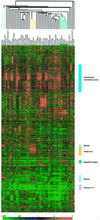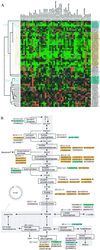Delineating developmental and metabolic pathways in vivo by expression profiling using the RIKEN set of 18,816 full-length enriched mouse cDNA arrays
- PMID: 11226216
- PMCID: PMC30115
- DOI: 10.1073/pnas.041605498
Delineating developmental and metabolic pathways in vivo by expression profiling using the RIKEN set of 18,816 full-length enriched mouse cDNA arrays
Abstract
We have systematically characterized gene expression patterns in 49 adult and embryonic mouse tissues by using cDNA microarrays with 18,816 mouse cDNAs. Cluster analysis defined sets of genes that were expressed ubiquitously or in similar groups of tissues such as digestive organs and muscle. Clustering of expression profiles was observed in embryonic brain, postnatal cerebellum, and adult olfactory bulb, reflecting similarities in neurogenesis and remodeling. Finally, clustering genes coding for known enzymes into 78 metabolic pathways revealed a surprising coordination of expression within each pathway among different tissues. On the other hand, a more detailed examination of glycolysis revealed tissue-specific differences in profiles of key regulatory enzymes. Thus, by surveying global gene expression by using microarrays with a large number of elements, we provide insights into the commonality and diversity of pathways responsible for the development and maintenance of the mammalian body plan.
Figures





References
-
- DeRisi J L, Iyer V R, Brown P O. Science. 1997;278:680–686. - PubMed
-
- Behr M A, Wilson M A, Gill W P, Salamon H, Schoolnik G K, Rane S, Small P M. Science. 1999;284:1520–1523. - PubMed
-
- White K P, Rifkin S A, Hurban P, Hogness D S. Science. 1999;286:2179–2184. - PubMed
-
- Carninci P, Hayashizaki Y. Methods Enzymol. 1999;303:19–44. - PubMed
Publication types
MeSH terms
Substances
LinkOut - more resources
Full Text Sources
Other Literature Sources
Molecular Biology Databases

